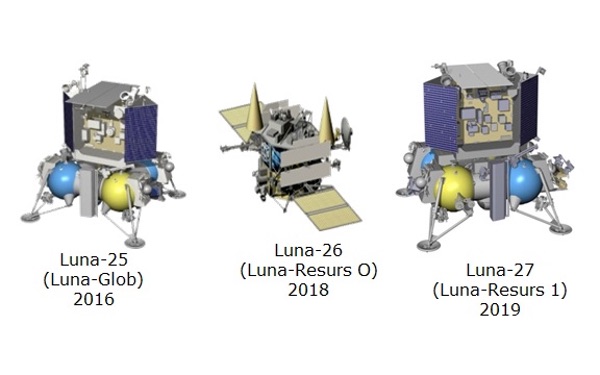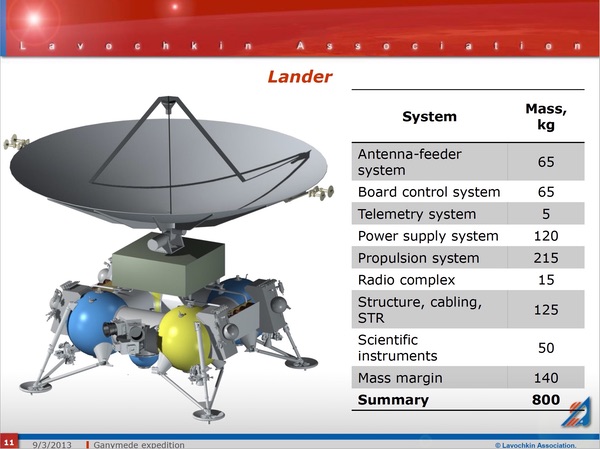There are no Russians there…by Dwayne A. Day
|
| The once-proud Russian space program has not been short of ideas, nor even short of money. It has, however, been short of any kind of organization or management, as well as the experienced workforce, required for accomplishing anything beyond low Earth orbit. |
But as recently as a few years ago, Russian scientists had outlined an impressive set of lunar exploration plans of their own, including landers at the lunar poles, drilling instruments, and even a sample return spacecraft. Those plans have continuously shrunk and launch dates have receded, and Russia’s independent planetary exploration ambitions have essentially disappeared. While many other countries seek to send spacecraft to the Moon and Mars, Russia’s space program will only go to the planets if somebody else agrees to pay most of the bill.
By now it has been almost 30 years since the last even partially successful Russian planetary mission. After sending many spacecraft to the Moon, Mars, and Venus, Soviet planetary exploration collapsed with the Soviet Union. The once-proud Russian space program has not been short of ideas, nor even short of money. It has, however, been short of any kind of organization or management, as well as the experienced workforce, required for accomplishing anything beyond low Earth orbit.
During the 1990s many Russian space scientists went unpaid and had no new missions to work on. The lucky ones moved to the West, some finding jobs in European scientific institutions and a few even ending up in the United States. Many others simply left their fields entirely. By the turn of the century, there were few experienced space scientists left in the country.
The few scientists who remained still talked about future plans that looked not so much impressive as borderline delusional. In 2010, a Lavochkin Association presentation indicated up to 33 Russian planetary missions planned between 2012 and 2020—a rate of about four per year, far higher than NASA, which averages about a handful of planetary missions per decade. In 2011, Russian science presentations showed numerous planned missions to the Moon, Mars, Mercury, and Venus, none of which have been built. (See “Red Planet blues”, The Space Review, November 28, 2011.)
These lofty Russian plans were thrown into stark relief by late 2011. In November of that year, Russia launched a technically impressive mission to the Martian moon Phobos that never even escaped Earth orbit. The Fobos-Grunt spacecraft was supposed to travel to Mars, touch down on one of the two moons of Mars, grab some soil, and bring it all the way back to Earth. Had it worked, it would have been an incredible and unrivaled achievement in planetary science. But it was overly ambitious given Russian experience during the preceding quarter-century. The previous Russian planetary science mission, known as Mars 96, had not even made it to Earth orbit and may have plowed into an Andean mountainside. Before that, the Fobos 2 mission had entered Mars orbit in January 1989, but failed soon thereafter.
The failure of Fobos-Grunt left the Russian planetary program in search of other goals, and soon their attention turned to the Moon. Early this decade Russian scientists produced papers showing a series of up to half a dozen robotic lunar missions of increasing sophistication, including deep drilling, polar ice analysis, and sample return. In 2013, two years after the Fobos-Grunt failure, the Russian space agency announced that its next planetary science mission would launch in 2015 and would orbit the Moon, followed by a lander a year later (see “A Russian Moon?”, The Space Review, January 28, 2013.)
| There was no reason to believe that the government leadership would approve unimpressive space science missions that would not compare well with what other countries were doing. |
Neither mission has yet launched, and every new announcement about them seems to push them further into the future. The lander, formerly named Luna-Glob but renamed Luna 25 to emphasize continuity with the Soviet Luna series of missions that ended in 1976, was scheduled for a 2016 launch, then 2019, but is now apparently scheduled for 2021, with the orbiter now delayed to 2022. Although Russian television released images several years ago of what was apparently engineering test hardware for a Russian lunar lander, it is unclear when, or even if, Russian lunar plans are moving forward despite official pronouncements.
 Russia has outlined a series of increasingly ambitious robotic lunar missions for many years now, such as this chart from a 2014 presentation. But it is unclear when, or even if, the first of these missions will fly. (credit: ESA) |
From the early 2000s until at least a few years ago the Russian planetary science program seemed to have ended up in a conundrum: national pride—and perhaps the only way to get government funding—meant that they would only propose bold and ambitious space missions that did what no other country had done before, but such missions were also beyond their engineering capability to accomplish.
Realistically, what the Russian space program needed was a series of less ambitious but achievable missions that would allow the country to rebuild its engineering and scientific capabilities by training a younger generation—learning once again how to crawl before they could start walking. But there was no reason to believe that the government leadership would approve unimpressive space science missions that would not compare well with what other countries were doing. With American rovers on Mars and spacecraft orbiting Mercury, Mars, Saturn, and Jupiter, as well as flying past Pluto; with China landing a rover on the Moon; and with even India orbiting Mars, any Russian planetary space mission that did not do something with substantial publicity benefit seemed like a non-starter. Now Japan is building a Phobos sample return spacecraft aiming to accomplish in the 2020s what Fobos-Grunt was supposed to do.
Fortunately for the Russians, the Europeans came knocking at their door. This was the result of the United States canceling a joint NASA-European Space Agency agreement on the exploration of Mars in 2011. Although internal Russian government deliberations on the subject are unknown, senior officials were apparently more willing to approve plans to cooperate with the Europeans on Mars than to fund a Russian lunar exploration effort. Russia is now developing a lander for the European ExoMars rover, with the goal of launching in 2020. Reportedly, 80 percent of the lander will be built by the Russian company Lavochkin and the remaining 20 percent—consisting of the guidance, radar, and navigation—will be built by ESA, although exactly how that 80/20 split is calculated is unclear. If ExoMars works, this will get the Russians back into planetary science through a back door, but even if Russia contributes substantial funding to the mission, it is clear that the Europeans are setting the goals.
| If the human spaceflight program is suffering, there is no reason to believe that the Russian planetary space effort, no matter how nascent, is immune. The Europeans relying upon Russian Mars hardware are almost certainly nervous about their partners. |
At the same time that Russian lunar plans were collapsing, China’s have been ascending. China’s successful Chang’e-3 mission that placed a lander and the Yutu rover on the lunar surface will be followed by the Chang’e-4 lander and rover on the lunar farside. China has also announced plans for a nearside sample return mission and possibly even a South Pole-Aitken Basin sample return mission which would achieve a top American scientific goal for the Moon. That Chinese lunar exploration program is more ambitious than even the abandoned Russian plans of only a few years ago, and more ambitious than NASA’s current robotic lunar plans. (A few weeks ago an American official revealed details of a previously-secret 2013 deal with China concerning the Chang’e-3 landing; the United States upheld its part of the agreement, but China did not.) China is also planning an extremely ambitious 2020 Mars mission that would include an orbiter, lander, and rover. India currently has a spacecraft orbiting Mars long past its design life, and is working on more ambitious missions.
 An illustration from a 2013 Lavochkin Association presentation about a proposed Ganymede lander. There have been many Russian proposals for advanced planetary spacecraft in the last decade, but the country is unable to perform even the most basic missions, while India currently orbits Mars and China is landing rovers on the Moon. (credit: Lavochkin Association) |
The recent Soyuz launch abort demonstrates how far the Russian space program has fallen. Spaceflight has never been easy, but while other parts of the Russian space infrastructure had suffered failures, human spaceflight at least seemed protected. Not anymore. And if the human spaceflight program is suffering, there is no reason to believe that the Russian planetary space effort, no matter how nascent, is immune. The Europeans relying upon Russian Mars hardware are almost certainly nervous about their partners.
Today’s InSight Mars landing kicks off what will be an exciting five weeks of planetary science for the United States, China, and Japan. OSIRIS-REx arrives at asteroid Bennu next week, followed by the Chang’e 4 liftoff. At the turn of the New Year there will be New Horizons’ flyby of Ultima Thule, Japan’s Hyabusa2 spacecraft will wake up from its temporary slumber and resume investigating its asteroid 162173 Ryugu, and then Chang’e 4 will land on the lunar far side.
In a recent article, Russian space expert Jim Oberg pointed out the internal management problems that have contributed to Russian mission failures. He referred to a poem by Sergey Zhukov, a cosmonaut trainee, spaceflight advocate, and high official. Troubled by their crumbling space program, several years ago Zhukov wrote a poem entitled “Epitaph for the Russian Space Agency (1992–2015).” Oberg’s translation of Zhukov’s poem perfectly describes what has happened to the Russian planetary space exploration program:
The students flowed westward
The doctors - who is in China, who in Iran?
Only the movie film’s yellowed tape
Preserved the prestige of Russians.
Erecting a heap of paper,
Our officialdom grew sickly and shallow…
And he stands, in tears,
On the threshold of the universe, the poet.
He looks through opened eyes
Into deep space, and there are no Russians there…
Note: we are temporarily moderating all comments subcommitted to deal with a surge in spam.
